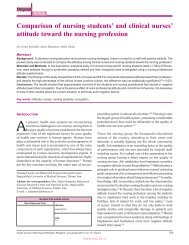Gastrointestinal Nursing.pdf
Gastrointestinal Nursing.pdf
Gastrointestinal Nursing.pdf
You also want an ePaper? Increase the reach of your titles
YUMPU automatically turns print PDFs into web optimized ePapers that Google loves.
The Large Intestine 81of water and ions is via the enteric nerve plexi. Hormonal control of waterabsorption in the colon is achieved by production of aldosterone. Anti-diuretichormone (vasopressin) decreases water absorption in this region.Intestinal bacteriaMost of the microbial cells that colonise the body reside in the large intestine.A large number of bacteria are excreted in human faeces and more than 99%of these bacteria are non-sporing, anerobes. Apart from these anerobic bacteria,lactobacilli and coliforms also reside in the large bowel. These bacteria synthesisevitamins which are required by the body: vitamins of the B complex(thiamine, riboflavin and vitamin B 12 ) and vitamin K. The production of vitaminK is of particular importance but it is deficient in the average diet and isrequired for normal blood clotting. Vitamin K is fat-soluble and is thereforeeasily absorbed in the large bowel. Other vitamins are absorbed by passivediffusion in the colon, and a small number of vitamins which have moved tothe small intestine via reflux may be absorbed in this region.Intestinal bacteria also display digestive functions. They are involved in theconversion of primary bile acids to secondary bile acids and in the deconjugationof conjugated bile acids. Colonic bacteria also convert bilirubins to colourlessderivatives known as urobilinogens, which are absorbed directly into the blood.These pigments are mostly excreted in the bile but some are excreted in theurine. Urobilinogen remaining in the gut is partially reoxidised to strercobilinogen,the reddish-brown pigment responsible for the colour of faeces.PATHOPHYSIOLOGY OF THE LARGE INTESTINEAmong the diseases and disorders that affect the large bowel are intestinalpolyps, irritable bowel syndrome, diverticular disease, inflammatory boweldisease and tumours of the colon.Colonic polypsColonic polyps are elevated areas above the mucosal surface into the lumenof the bowel. Polyps range in appearance from tiny translucent and almostinvisible bumps only 1–2 mm in diameter to those having a head 1–3 cmin diameter on a vascular stalk. They may be single or may occur togetherin small numbers, or in hundreds. Diagnosis is achieved by colonoscopyor proctosigmoidoscopy. Most polyps are asymptomatic, but some patientsexperience intermittent bleeding which can cause mild anaemia. Very largepolyps can result in excessive mucus production, altered bowel habit andabdominal pain.















